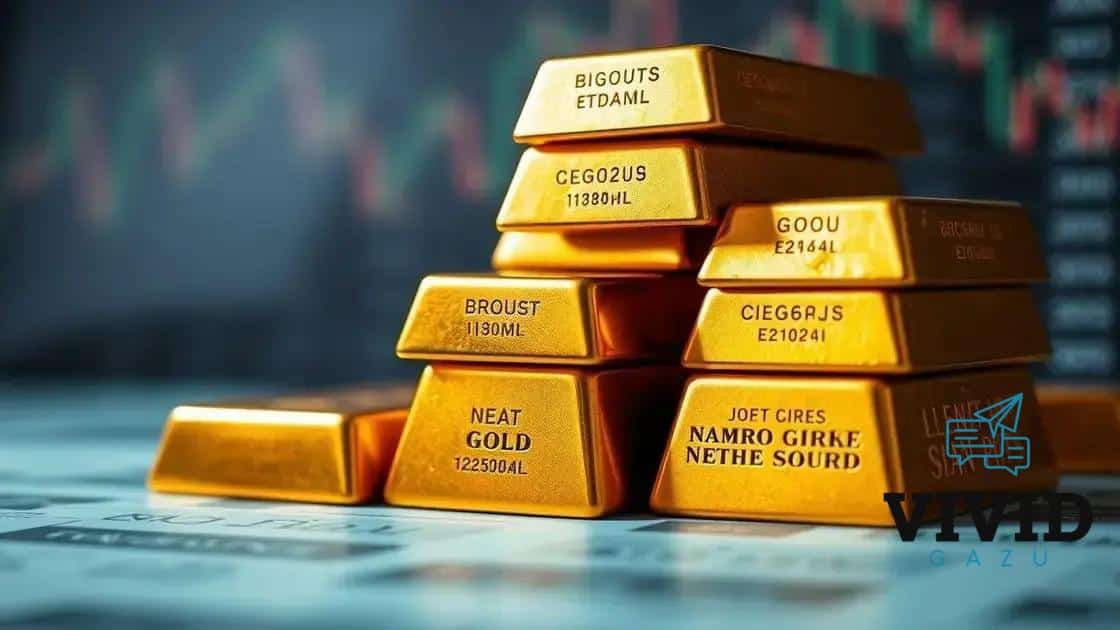Why gold remains a hedge during global downturns

Gold remains a reliable hedge during global downturns due to its historical stability, ability to retain value amid market volatility, and continued demand as a safe haven investment.
Why gold remains a hedge during global downturns is a question often pondered by investors. With economic fluctuations becoming more frequent, many wonder how gold maintains its value. Here, we’ll explore this intriguing topic.
Understanding gold’s historical stability
Gold has a long history of being a valuable asset, often viewed as a safe haven. Its historical stability is key to understanding why investors choose gold, especially during economic turbulence.
Throughout history, gold has been a reliable form of currency and a store of wealth. Various civilizations have utilized gold for trade, showcasing its worth.
Key Factors Contributing to Gold’s Stability
Several factors contribute to the stability of gold, making it an attractive option during downturns:
- Limited supply: Gold is a finite resource, which helps maintain its value over time.
- Global acceptance: Unlike currencies, gold is universally recognized and can be traded almost anywhere.
- Inflation hedge: Gold often retains its value even when inflation rises, protecting investors’ purchasing power.
As economic conditions fluctuate, people turn to gold due to its historic reliability. Its price movement tends to differ from stocks and bonds, which can be more volatile.
Gold’s Performance During Economic Crises
During past financial crises, such as the 2008 recession, gold prices surged as investors sought safe assets. This trend is evident in various market conditions where fear and uncertainty dominate.
Many people consider investing in gold to diversify their portfolios. Diversification helps mitigate risk, especially in uncertain times. Gold can provide a buffer against market drops.
Understanding gold’s historical stability is essential for those looking to safeguard their investments. By appreciating this aspect of gold, investors can make informed choices amid economic upheaval.
The role of gold in economic uncertainty

During times of economic uncertainty, gold plays a vital role as a safe haven asset. Investors often turn to gold as a reliable store of value when faced with market volatility and financial instability.
The historical significance of gold emphasizes its enduring worth. People have trusted gold for centuries, making it a cornerstone of wealth preservation. This trust is only heightened when economic conditions become unpredictable.
Why Gold is Seen as a Safe Haven
There are several reasons why gold is viewed as a safe haven:
- Value retention: Unlike cash or stocks, gold often maintains its value during downturns.
- Inverse relationship with the dollar: When the dollar weakens, gold prices tend to rise, providing a counterbalance.
- Global acceptance: Gold is recognized worldwide, making it easy to buy or sell, regardless of local economic conditions.
Investors often include gold in their portfolios to hedge against losses in other assets. This strategy provides a safety net, especially during challenging economic times.
Historical Context of Gold During Crises
Past economic crises illustrate gold’s role effectively. For example, during the 2008 financial crisis, gold prices soared as investors sought security. Similarly, during geopolitical tensions, gold becomes increasingly valuable.
As markets fluctuate, the demand for gold often increases, driving prices higher. This reaction highlights its effectiveness as a hedge during periods of economic uncertainty. Investors who recognize this dynamic can better protect their assets.
How gold compares to other assets
When considering investments, it’s essential to understand how gold compares to other assets. Gold has unique qualities that set it apart, making it a popular choice, especially in unpredictable markets.
Unlike stocks and bonds, gold is a tangible asset that often retains value. This retention is critical during times of market volatility. It acts as a hedge against inflation and currency devaluation, offering security for investors.
Gold vs. Stocks
Historically, stocks provide higher returns over the long term. However, they come with increased risk. During economic downturns, stock prices can plummet, leading to significant losses. Gold, on the other hand, typically holds its value or even appreciates during these times.
- Gold is less volatile than stocks, offering more stability.
- Investing in gold provides diversification in a portfolio.
- While stocks can yield dividends, gold provides a different kind of security.
This comparison highlights why investors often look to gold when the stock market is uncertain.
Gold vs. Real Estate
Real estate is another popular asset class, but it has its challenges. Gold’s liquidity is one of its advantages; it can be quickly converted into cash, while real estate transactions can take much longer. Additionally, gold doesn’t require maintenance like property does.
Investing in gold can also be less risky than real estate during economic instability. It doesn’t involve the long-term commitments or costs associated with owning property, such as taxes and upkeep.
In summary, understanding how gold compares to other assets is vital for anyone looking to invest wisely. Each asset class has its benefits, but gold’s unique characteristics make it a valuable addition to a diversified investment strategy.
Strategies for investing in gold during downturns
Investing in gold during economic downturns can be a wise decision. Having the right strategies can help you make the most of this asset. Understanding when and how to invest is essential to protect your wealth.
One effective strategy involves buying gold when prices are low. During downturns, the price of gold can fluctuate. By timing your purchases, you can secure a better deal and maximize your potential returns.
Dollar-Cost Averaging
Another approach is to use dollar-cost averaging. This means investing a fixed amount of money in gold at regular intervals, regardless of its price. This strategy helps to spread risk and can lead to buying more gold when prices drop.
- This method reduces the impact of market volatility.
- It makes investing less stressful.
- Dollar-cost averaging can build a solid position over time.
Another noteworthy strategy is diversification within your gold investments. Consider different forms of gold, such as ETF (Exchange-Traded Funds), gold coins, or gold bullion. Each option has its own pros and cons.
Staying Informed and Flexible
Staying informed about market trends is crucial for effective investing. Keep an eye on economic indicators that affect gold prices, such as inflation rates and currency strength. Being aware of these factors can help you make timely decisions.
Finally, it’s essential to remain flexible. The market can change quickly, and being ready to adjust your strategies is vital. If the economic situation improves, you may want to reconsider your gold holdings.
By employing these strategies, you can navigate the complexities of investing in gold during downturns and potentially enhance your financial security.
Future outlook for gold in volatile markets
The future outlook for gold in volatile markets is a topic of great interest among investors. Gold has historically been seen as a refuge during times of economic uncertainty, and its role is likely to continue evolving.
As global economies face challenges, many anticipate that demand for gold will remain strong. Factors such as inflation, political instability, and fluctuating currencies can enhance gold’s appeal. Investors often turn to gold when traditional markets become unpredictable.
Factors Influencing Gold Prices
Several key factors can influence the future price of gold:
- Inflation rates: When inflation rises, gold generally becomes more valuable as it preserves purchasing power.
- Interest rates: Lower interest rates can boost gold prices, as they reduce the opportunity cost of holding gold.
- Geopolitical tensions: Conflicts and instability often lead investors to flock to gold for safety.
Additionally, the strength of the US dollar plays a significant role. A weaker dollar typically results in higher gold prices, as gold becomes less expensive for foreign investors.
Investor Behavior and Sentiment
The behavior and sentiment of investors will also shape gold’s future. If economic uncertainty persists, many may increase their gold holdings. This heightened demand can lead to price increases over time.
It’s important to watch market trends closely. Analysis of economic indicators, such as job reports and GDP growth, can provide insights into when investors may prefer gold over other assets. Keeping an eye on these trends helps in making informed investment decisions.
The adaptability of gold to different economic scenarios reinforces its position as a safe investment. Whether facing inflationary periods or market drops, gold will likely continue to be a favored choice for many looking to protect their wealth.
FAQ – Frequently Asked Questions about Gold Investment
Why is gold considered a safe investment during economic downturns?
Gold is viewed as a safe asset because it tends to retain its value when other investments fluctuate, providing security for investors.
What factors influence the price of gold?
Gold prices are influenced by inflation rates, interest rates, geopolitical events, and the strength of the US dollar.
How can I effectively invest in gold?
Effective strategies include dollar-cost averaging and diversifying your gold investments among coins, bars, and ETFs.
What is the outlook for gold in volatile markets?
The outlook for gold remains positive as it continues to attract investors during times of uncertainty, particularly against inflation and political instability.





